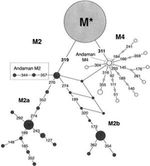Ancient mitochondrial DNA sequence and SNP data from Andaman and Nicobar museum samples
Phillip Endicott, 2014. https://doi.org/10.5284/1000381. How to cite using this DOI
Data copyright © Dr Phillip Endicott unless otherwise stated
This work is licensed under the ADS Terms of Use and Access.
Primary contact
Dr
Phillip
Endicott
UMR 7206 Eco-anthropologie
Equipe "génétique des populations humaines"
Musée de l'Homme
CP 139
57 rue Cuvier
75231 Paris
Cedex 05
France
Tel: 00331 40798154
Resource identifiers
- ADS Collection: 925
- DOI:https://doi.org/10.5284/1000381
- How to cite using this DOI
Introduction

The aim of this project was to reconstruct the maternal demographic history of the populations of the Andaman and Nicobar archipelagos using genetic profiles obtained from colonial era skeletal material and hair collections. The project had two main technical arms: to obtain authentic DNA data from well-handled museum collections of human material, which were a priori presumed to be heavily contaminated; to use the data to fill in lacuna in the genetic landscape left by large-scale demographic decline caused by disease and social disruption associated with the modern era. The major aim of the interpretative phase of the project was to obtain realistic estimates for the date of settlement of these island groups based on genetics because of the absence of reliable archaeological evidence. The main aim of this research was to determine whether the Andaman islanders were part of a very early radiation from Africa or arrived to their archipelago much later. The Nicobars were included in the research to have a comparative data set from the same region from people with a different phenotype. The data set is comprised of mitochondrial DNA control region sequences and coding region Single Nucleotide Polymorphisms.





